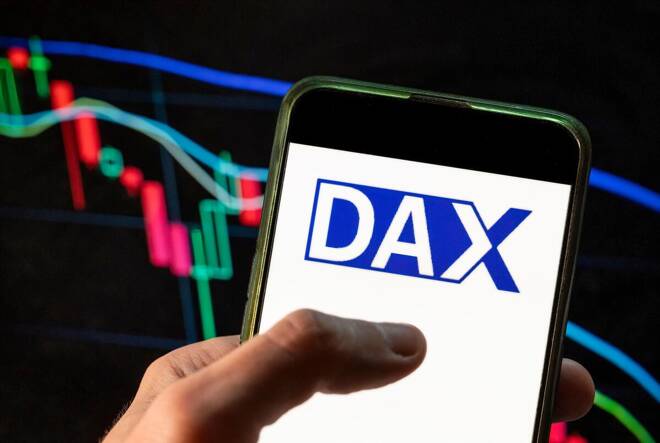Advertisement
Advertisement
DAX Index: Recessionary Jitters, Euro Area Stats, and ECB Commentary
By:
Short-term DAX outlook: ECB commentary and US CPI Report are near-term focal points ahead of the earnings season, as recessionary fears linger.
Highlights
- The DAX declined by 0.17% on Tuesday, ending the session at 16,688.
- An unexpected fall in German industrial production contributed to the loss.
- On Wednesday, euro area economic indicators and ECB commentary need consideration.
Overview of the DAX Performance on Tuesday
The DAX declined by 0.17% on Tuesday. Partially reversing a 0.74% gain from Monday, the DAX ended the Tuesday session at 16,688.
German Industrial Production and Eurozone Unemployment
On Tuesday, the German economy was in the spotlight for the second session. German industrial production was in focus after weaker-than-expected German factory orders and a slide in retail sales.
Industrial production unexpectedly declined by 0.7% in November after falling 0.3% in October, raising more recessionary flags. The latest report from Germany followed the Sentix Indicator for January that continued to signal a German recession. Significantly, Germany’s economic woes could impact the Eurozone economy.
Eurozone unemployment figures offered little relief despite falling from 6.5% to 6.4% in November.
US Economic Optimism Improved in 2024
On Tuesday, the RCM/TIPP Economic Optimism Index provided late support. The Index increased from 40.0 to 44.7 for January, supporting bets on a soft landing. However, investor caution before the US CPI Report on Thursday and US bank earnings on Friday countered the upbeat numbers.
On Tuesday, the S&P 500 and the Dow saw losses of 0.15% and 0.42%, respectively. The Nasdaq Composite Index gained 0.09%.
The Tuesday Market Movers
Recessionary jitters left Infineon Technologies and Siemens Energy AG with losses of 1.76% and 0.95%, respectively. Bank stocks also ended the day in negative territory ahead of US bank earnings results on Friday. Commerzbank and Deutsche Bank declined by 0.72% and 0.09%, respectively.
However, autos had a mixed Tuesday session. Mercedes-Benz Group and Porsche saw gains of 0.38% and 0.13%, respectively. Volkswagen and BMW ended the day down 0.58% and 0.38%, respectively.
Volkswagen delivery numbers for 2023 failed to drive buyer demand for auto stocks. According to the Tuesday press release, global vehicle deliveries increased 6.7% year-over-year in 2023. Significantly, all-electric vehicle deliveries jumped 21.1%. Warnings of another challenging year in 2024 likely spooked investors.
Euro Area Economy in the Spotlight
On Wednesday, the investor focus will turn to euro area member state economic indicators. Industrial production numbers from France and retail sales figures from Italy warrant investor attention.
Amidst an increasing threat of a euro area economic recession, weaker numbers could impact buyer demand for DAX-listed stocks.
Economists forecast French industrial production to stall in November after falling by 0.3% in October. However, economists expect Italian retail sales to increase by 0.1% in November after rising by 0.4% in October.
Beyond the numbers, ECB commentary also needs monitoring. ECB Executive Board members Luis de Guindos and Isabel Schnabel are on the calendar to speak on Wednesday. Comments on the economic outlook, inflation, and interest rates would move the dial.
US Economic Calendar: US CPI Report in Focus
After the better-than-expected US Jobs Report, investors will begin considering the US CPI Report (Thurs). An unexpected pickup in US core inflationary pressures could test bets on a Q1 Fed rate cut. Falling bets on a Q1 Fed rate cut could affect the appetite for riskier assets.
There are no US economic indicators for investors to consider on Wednesday. However, investors must monitor Fed commentary. Reaction to the recent US Jobs Report and views on inflation and interest rates need consideration.
In the futures, the DAX was down 28 points. The Nasdaq mini was up 5 points.
Short-Term Forecast
Near-term DAX trends will hinge on ECB commentary and the US CPI Report. An increasing threat of a euro area recession, hawkish ECB comments, and a hotter-than-expected US CPI Report could pressure the DAX.
DAX Technical Indicators
Daily Chart
The DAX sat well above the 50-day and 200-day EMAs, sending bullish price signals.
A DAX move through the January 2 high of 16,964 would bring the all-time high (AHT) of 17,003 into play.
Euro area economic indicators and central bank commentary are in focus.
However, a drop below the 16,600 handle would support a fall toward the 16,470 support level.
The 14-day RSI reading of 59.66 indicates a DAX return to the 17,000 handle before entering overbought territory.
4-Hourly Chart
The DAX remained above the 50-day and 200-day EMAs, affirming bullish price signals.
A DAX break above the January 2 high of 16,964 would support a move to the ATH of 17,003.
However, a break below the 50-day EMA would support a fall toward the 16,470 support level.
The 52.68 14-4 hour RSI indicates a DAX return to the 17,000 handle before entering overbought territory.
For a look at the economic events, check out our economic calendar.
About the Author
Bob Masonauthor
With over 28 years of experience in the financial industry, Bob has worked with various global rating agencies and multinational banks. Currently he is covering currencies, commodities, alternative asset classes and global equities, focusing mostly on European and Asian markets.
Advertisement
